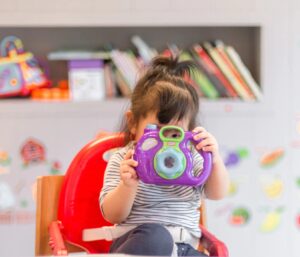By Iris Farrou
17 Mar, 2023
Early Childhood Education, Fatherhood, Lifestyle Tips, New Moms, Parenting, Toddler Health
Cognition, Cognitive Abilities and Functions, Early Childhood Development, Healthy Brain Development, Language Development, PreK, Prekindergarten, Teaching How to Read, Toddler Education

One of the biggest milestones in a toddler’s life is when they first start to use words and display other communication skills, beyond crying. Early language development may look different for each toddler–we do have to remember they are individual people, after all–but here are some key milestones that are expected for each age group:
1 year old: by this time, your toddler should be able to say a handful of words. Of course, this is in addition to babbling, and the key skill of trying to imitate your voice! They are trying to imitate the sounds they hear, and at this age you should be hearing consonants and vowels coming clearly out of your baby’s mouth. You may also notice that they are using hand and body gestures to communicate certain needs or activities, like pointing to their toys for play time or touching their mouth for snacks. This is a normal process of cognitive development, and you can help enhance it by talking to them as much as possible and helping them follow simple directions by associating words with movements, like saying “up” and helping lift them.
2 years old: this is the point where your toddler should have a steady vocabulary they are repeating, and they begin to expand it. You can help them by reading more and more stories to them, or using more advanced language than before. Additionally, they are able to comprehend sentence structure (slowly) and you may see them using two-word sentences and linking words. Building on their conquered skills of body gestures, they are now able to identify objects and body parts and clearly name them. 2 y/os may also exhibit understanding of slightly more abstract concepts, such as using pronouns.
3 years old: your toddler should have advanced to forming simple sentences and speaking clearly by this age. This goes hand in hand with their ability to string multiple words together. You can help expand this skill by repeating their word combinations back to them every time they use them, and model new word combinations to encourage them to try them. Toddlers at this age are also able to use the correct words to identify both objects and needs. Since their cognitive abilities are growing, you will also notice they can follow two part requests like “Please pick up your shoes and put them on the shelf.”
4 years old: this is considered an age when your toddler is turning into a child, so you will see more advanced language patterns emerge– like them creating more complex sentences and annunciating them clearly. Your child should also be able to identify shapes, colors, and letters, especially if those appear on objects they see often. Their ability to understand more abstract concepts will be more advanced, and they start recognizing the concept of time, like moments throughout the day. It is not unlikely that your child can now follow complex requests, and voice their own wants and needs in more complex sentences, or multi-part sentences.
https://www.parents.com/toddlers-preschoolers/development/language/language-development-milestones-ages-1-to-4/
https://www.teachearlyyears.com/learning-and-development/view/7-ways-to-support-language-development
More
By Iris Farrou
10 Mar, 2023
Fatherhood, Lifestyle Tips, New Moms, Parenting, Queer Health, Reproductive health, Your baby's health
Baby Etiquette, health tips before meeting newborn baby, Meeting Your Baby, New Parents, Newborn, Visiting a baby, When can I meet a new baby

Whether you are a parent, a close friend, or a family member, the arrival of a newborn is exciting, and no doubt you are looking forward to meeting the new member of the group! Many close family members tend to directly assume they can visit the newborn, while friends and extended family may be a little more careful. However, there is no one-rule-fits-all when it comes to these situations. In fact, the key rule is to check in with the parents first as this is solely their decision: childbirth is a painful and difficult journey, no matter how rewarding it may be. The new family may or may not feel comfortable accepting guests.
What can both guests and hosts do to make this experience enjoyable, and most importantly, safe for the baby?
The 4 DOs
- Discuss with your partner beforehand how you want to handle guests: who is allowed to visit fresh out of the hospital and for how long? Communicate your decisions to family and friends.
- Check in with the new parents about the visit: schedule a visit, check in at the last minute, respect any changes; follow the new family’s rules.
- Be up to date with your vaccines, visit only if you are feeling well, wash your hands before touching the baby, and remove any jewelry from your hands.
- It’s very important to offer to help if you are visiting a family with a newborn: whether that’s bringing a meal, or taking their dog out for a walk, it can be of tremendous help to the new parents.
Here are some actions that are ill-advised when visiting a newborn:
The 4 DON’Ts
- Babies are susceptible to germs and viruses: don’t take your newborn into crowded, or loud, places before they’ve had time to build their immune system. If you need to get out of the house, ask for help taking care of the baby.
- Don’t bring little kids– while no doubt they are also looking forward to meeting the new baby, little kids carry the additional risk of germ exposure. Also, extra visitors can cause more anxiety for the new parents.
- Avoid putting your face close to the baby’s. Adorable as it may be, such close contact is a risk as mouths carry a lot of germs. Don’t be surprised if the parents ask you to wear a mask.
- Don’t take pictures of the baby without the parents’ permission! Most importantly, don’t post pictures on social media without asking the parents first.
Of course, this is not a comprehensive list of what you should or shouldn’t do when visiting a family with a newborn–just some basic rules you should follow to make it more comfortable for the new parents and to avoid any misunderstandings. Some families are ok with much more socialization than you may expect, and may actively seek it, while some others may choose to be more reclusive when they bring their new baby back home from the hospital. Always follow the family’s rules and decisions!
https://www.hopkinsallchildrens.org/ACH-News/General-News/New-Parents-and-Newborns-Are-Visitors-OK
https://www.owletcare.com/blog/7-key-rules-visiting-newborn
More
By Iris Farrou
28 Feb, 2023
Lifestyle Tips, PMS, Prevention, Procedures, Queer Health, Reproductive health, Sexual health, Women's Health
cysts, Fibroid Cluster, Heavy Periods, Infertility help, MRI, Ovarian, Reproductive system disorders, Symptoms, Ultrasound, Uterine Cancer, Uterine Fibroids, Womens Reproductive Health

If you have a uterus, then you already know there are countless issues to keep in mind and a full maintenance schedule for your uterine health. There is yet another concept to add to your list: uterine fibroids. Ideally, your OBGYN or primary care doctor has already talked to you about these. But if this is the first time you come across this term, fear not–uterine fibroids are extremely common, and 99% of the time they are also harmless. However, that does not mean you should ignore them, or that they don’t contribute their fair share of challenges in your cycle.
What are uterine fibroids and how do I know I have them?
Uterine fibroids, also known as leiomyomas, are quite simple: they are noncancerous growths (or tumors, though that word is admittedly scary) made up of the connective tissue and muscle from the wall of the uterus. They can grow solo, or in a cluster, and are most commonly less than 8 inches in diameter– though they can grow larger. Many people with a uterus do not even realize they have uterine fibroids, unless some of the symptoms start becoming more prominent, or you specifically ask your OBGYN to look for them.
The most common signs of uterine fibroids include heavy menstrual bleeding, periods lasting more than a week, bleeding between your periods, frequent urination or difficulty emptying your bladder–usually resulting in a feeling of heaviness in your lower abdomen–constipation, lower back pain, and even pain during sex. These symptoms are definitely not an exclusive list, and presence of such symptoms does not guarantee the only issue is uterine fibroids: if you have concerns, it is advised that you consult with your doctor so you can know exactly what you are dealing with.
How are they diagnosed and treated?
If you are concerned about the presence of uterine fibroids, you can ask to have an ultrasound done to determine the presence of uterine fibroids. The ultrasound can be transabdominal, and/or be done inside your vagina to get pictures of the uterus. Your doctor may also order blood count tests to determine if you have anemia from chronic blood loss, and to rule out other bleeding disorders. If these methods do not yield satisfactory results, there are more in depth tests that your OBGYN can order, such as an MRI, hysterosonography, or hysteroscopy.
Since uterine fibroids are benign, the recommended treatment–as long as they are not causing significant issues in your day to day life and do not interfere with your fertility–is to keep an eye on them. They rarely grow and do not tend to interfere with fertility and/or pregnancy, and also tend to shrink after menopause. There are possible medications that your doctor may prescribe, medication which control your hormone levels to create menopause-like conditions. This tricks the fibroids into thinking your body has entered menopause, and causes them to shrink along with their unpleasant effects (such as heavy bleeding). Though there are procedures available as well, this is a step you would discuss at length with your doctor.
https://www.mayoclinic.org/diseases-conditions/uterine-fibroids/diagnosis-treatment/drc-20354294
https://my.clevelandclinic.org/health/diseases/9130-uterine-fibroids#diagnosis-and-tests
More
By Iris Farrou
23 Feb, 2023
Geriatric Mental Health, Heart health, Lifestyle Tips, Mental Health, Nutrition, Queer Health, Women's Health
aging parents, Buffalo OBGYN, Caring For My Elderly Parents, Changes with Aging, Elderly Parents, Family Dynamics, Geriatric, Grandparent Mental Health, Helping Parents with Disabilities, Multi-generation Families, OBGYN, Retired Parents

With the rising costs of living, it is becoming more and more common for families to be multi-generational and house family members of all ages under one roof. More often than not, this means that elders move in with their adult children, who may have their own young families. This is an option that families decide on between themselves, for a variety of reasons, and sometimes it is more financially feasible than living in an elders’ community or a home. In addition to the psychological and communication factors that come into play with such a decision, there are also practical accommodations that need to be considered– which are often overlooked when the aging family member appears able-bodied, but can cause serious trouble if not addressed.
Psychological and Communication Factors
If a new family member joins your existing family, this will necessarily change the family dynamic. All members of the welcoming family need to discuss the options available to them and decide whether adding an aging parent to their household is something they are comfortable doing. Of course, aging parents need to have a say in this: many people are not comfortable with the idea of being a dependant, or with the need to adjust to someone else’s schedule. It is a difficult transition for both parties, and it needs to be treated carefully. Keep in mind that in addition to the behavioral adjustments and changes, there will also be a need for practical changes in the home itself.
Practical Changes
There is a reason why many restaurants and facilities ensure they are ADA compliant, and similar adjustments need to be made in a home where an elderly person resides. The simplest examples of this would be to ensure there is a step-free entry, ideally one that can accommodate a wheelchair and/or walker. Of course, that also means there is a bedroom and full bathroom on the ground floor–possibly enforced with safety amendments like a handrail, non-slip mats, a shower chair, and raised toilet seat.
Practical adjustments don’t necessarily mean that your house will end up looking like a hospital–this popularized, and terrifying, idea only comes around when we talk about in-home hospice, for serious cases. However, basic adjustments do mean that your home will look different, and will probably not have any throw rugs: they are the number one tripping hazard for elderly people, along with pets who are not contained.
Diet and Healthcare
Another common change usually involves keeping tabs on the elderly person’s healthcare, and making adjustments to the usual diet to accommodate their needs. This can range from keeping track of medications, and securing them so that only the person who needs them has access to them, to scheduling doctor appointments, ensuring transportation, interpreting medical results, and advocating for the person you are caring for.
https://www.fda.gov/consumers/womens-health-topics/caring-others-resources-help-you
https://www.aarp.org/caregiving/home-care/info-2018/living-with-aging-parents.html?intcmp=AE-CAR-CAH-EOA1
More
By Iris Farrou
07 Feb, 2023
Health Conditions and Pregnancy, Lifestyle Tips, New Moms, Nutrition, Pregnancy, Queer Health, Women's Health
Healthy weight gain pregancy, How much weight should I gain in pregnancy, How to manage weight during pregnancy, Normal weight gain during pregnancy, Pregnancy diet, Pregnancy Nutrition
 If you are expecting, or are thinking of becoming pregnant, it is possible that you are also worried about your body weight. Many expecting mothers have faced this worry before, as pregnancy significantly alters your body and is expected (and should) increase your body weight. At the same time, you want to make sure that you experience a healthy pregnancy and don’t put yourself or your baby in danger. First of all, you should remember your baby weighs around 7-8 pounds– that’s a big chunk of pregnancy weight! Additionally, your placenta, a larger uterus, and amniotic fluid add about 2 pounds each. You will also experience an increased blood volume of 3-4 pounds, and increased fluid volume of 2-3 pounds, as well as larger breasts which add 1-3 pounds. It is important to remember that your fat stores, which are much needed for a healthy pregnancy and delivery, will add 6-8 pounds.
If you are expecting, or are thinking of becoming pregnant, it is possible that you are also worried about your body weight. Many expecting mothers have faced this worry before, as pregnancy significantly alters your body and is expected (and should) increase your body weight. At the same time, you want to make sure that you experience a healthy pregnancy and don’t put yourself or your baby in danger. First of all, you should remember your baby weighs around 7-8 pounds– that’s a big chunk of pregnancy weight! Additionally, your placenta, a larger uterus, and amniotic fluid add about 2 pounds each. You will also experience an increased blood volume of 3-4 pounds, and increased fluid volume of 2-3 pounds, as well as larger breasts which add 1-3 pounds. It is important to remember that your fat stores, which are much needed for a healthy pregnancy and delivery, will add 6-8 pounds.
Though these amounts may differ from person to person, the general weight added to a mother’s body by the end of pregnancy is about 30 pounds. Most expectant mothers gain 1-5 pounds in the first trimester and 1-2 pounds per week in the second and third trimester. According to the American Pregnancy Association, a pregnant woman of relatively normal weight who gets less than half an hour of exercise every week should have a calorie intake of 1,800 in the first trimester, 2,200 in the second trimester, and 2,400 in the third trimester. It is suggested that you limit processed foods, sugars, and extra fats when you are thinking about your diet while pregnant.
The first idea that pops into mind when thinking about a healthy diet during pregnancy is supplements and vitamins. Though these are definitely important, and prenatal vitamins ensure you don’t miss out on key nutrients, you do need to decide on the specifics by consulting with your doctor or healthcare provider. It is ideal to start taking a daily prenatal vitamin at least three months before conception. Discuss your options with your doctor before deciding, as supplements need to be tailored to add on to your current diet, any special diet, health conditions, and you need to know about possible supplements that do not have a good track record and may harm your pregnancy.
Other than supplements, the principle of any healthy diet applies to pregnancy as well– make sure you consume plenty of fruits, vegetables, whole grains, healthy fats, and lean protein. Here are the nutrients that deserve special attention during your pregnancy:
- Folate and Folic Acid: this helps decrease the risk of premature birth or low birth weight. It is also a B vitamin that helps the healthy development of the brain and spinal cord.
- Calcium: you may already know calcium is necessary for healthy bones and teeth, and both you and your baby need it. Did you know that calcium also helps the circulatory, muscular, and nervous systems?
- Vitamin D: this can work together with calcium to ensure healthy bones and teeth. Vitamin D is most commonly found in fatty fish, fortified milk, and orange juice.
- Protein: you want to keep on intaking protein throughout your pregnancy as it supports your baby’s overall growth and development. You need at least 71 grams a day.
- Iron: remember that during pregnancy you need double the amount of iron that non-pregnant persons need. The body uses iron to make hemoglobin, a protein in the red blood cells that carries oxygen to the body’s tissues. If you don’t get enough iron during your pregnancy, you may be at risk of developing anemia.
https://americanpregnancy.org/healthy-pregnancy/pregnancy-health-wellness/pregnancy-weight-gain/
https://www.mayoclinic.org/healthy-lifestyle/pregnancy-week-by-week/in-depth/pregnancy-nutrition/art-20045082
More
By Iris Farrou
13 Jan, 2023
Fatherhood, Lifestyle Tips, Mental Health, New Moms, Parenting, Toddler Health, Your baby's health
ADHD, Children, Learning Disabilities, Neurodivergence, Neurodivergent, Preschool, Toddler Mental Health

There is a general tendency for parents to become most concerned about their children’s neurological development when it’s time for their kids to join a preschool or other educational institution. A lot of schools are aware of, and keep an eye out, for behavioral patterns that may indicate a child is neurodivergent: this can span from what is commonly referred to as learning disabilities, to ADHD, and autism. Though schools can be a great resource in helping children with neurodiverse brains walk through life, the most important coping strategies and mechanisms come from the family unit itself. In fact, there are many signs well before a child joins the school system that they may have a neurodivergent brain.
What are those terms?
Neurotypical children are those whose brains develop in ways that are typical for their age and stage. About 1 in 5-6 children exhibit variations in their brain development, the most common of which are dyslexia, attention deficit hyperactivity disorder, and autism. These children can be described as neurodivergent. These differences are not something that needs to be treated, or fixed: rather, they are a part of natural variation. When we refer to treatments about neurodivergent children, we mainly talk about coping mechanisms by the child itself, the family, and the school system–in some cases, treatment does include medications as well, but in no case is the end goal to “fix” a child.
How do I recognize the symptoms?
Because we are talking about variations in the brains and its functions, there is no clean-cut way in which a parent can determine their child is neurodivergent. Instead, there is most usually a combination of signs in their behavior–and if you discuss the details of those with a physician or therapist, you can gain more insight into how to best accommodate your child. Let’s start with some symptoms that if persistent and repeated over the course of a few months, may indicate ADHD:
- Trouble with details and making careless mistakes
- Trouble focusing on tasks of at play, and trouble focusing when an adult speaks to them
- Challenges with following through on instructions, tasks, or homework as well as organizing
- Difficulty keeping track of their belongings and/or remembering things in daily activities
These are just a few of the signs of inattention, and if your child also displays issues of impulsivity or hyperactivity over a consistent period of time–usually more than 6 months–and seems to display 6 or more signs, you may want to consider consulting with a specialist.
https://raisingchildren.net.au/guides/a-z-health-reference/neurodiversity-neurodivergence-guide-for-families
https://www.iowaclinic.com/primary-care/specialties/pediatrics/early-warning-signs-adhd-children/
More
By Iris Farrou
13 Jan, 2023
Fatherhood, Lifestyle Tips, New Moms, Parenting, Pregnancy, Your baby's health
New Parents, Pregnancy, Prenatal, prenatal classes, Prenatal Education, Support

A vast number of expecting parents choose to educate themselves on issues of pregnancy, delivery, and caring for a newborn. Though documentaries and books are very helpful, birthing education classes are also a popular choice among prospective parents, or returning parents. Many couples find this to be a bonding experience, as both parties become educated on matters of prenatal care, delivery, and postpartum care. Additionally, it helps build a community–and even friendships–as concerns are shared among other expectant parents. Most importantly, you can share questions, concerns and fears in a safe and well informed environment with an experienced instructor by your side and become more and more confident in your body’s ability to give birth.
To start off, there are two types of classes: hospital-based ones and ones outside the hospital. In both cases, your instructor will discuss pain relief options, breathing techniques and medications, and even show you some supportive massage techniques. Emotional aspects, coping and relaxation skills, as well as the physiology of labor and birth are also topics covered in off-hospital birthing classes. Those are often the spaces where you discuss the different childbirth options.
If you opt for a hospital birth, and are taking a prenatal class located in a hospital, you will most likely receive a basic overview of labor and birth practices specific to the hospital of your choice. Additionally, you will get the chance to tour the facilities and see the staff in action and ask questions regarding routine practices–such as freedom of movement during labor.
However, even if you are starting from zero and have no idea about what method of childbirth you want to follow, how to construct a birth plan, what are the best practices that work for you during pregnancy and labor, it is important to consider some credible elements when choosing a birthing class:
- Make sure the instructor is certified to teach childbirth classes
- Consider whether the class’s philosophy suits you
- What are the topics covered in the curriculum and what is the cost of the class
- What is the extent of partner participation and education
- How many couples are in the class and how often does it take place
- Does the class focus on one birthing philosophy or multiple? How well rounded and open minded is the curriculum and the instructor?
You may locate credible birthing classes through your physician or hospital, family and friends, pregnancy centers, as well as community resource centers. Two Buffalo-based options include Buffalo Birth & Baby that covers a variety of areas, and offers support through all the pregnancy, delivery, and postpartum stages–and even offers online classes! Buffalo Doula Services offers not only educational materials and classes, but also hands-on support with widely experienced doulas to fit each family’s needs.
https://americanpregnancy.org/healthy-pregnancy/labor-and-birth/childbirth-education-classes/
https://buffalobirthandbaby.com/
https://www.buffalodoulaservices.com/
More
By Iris Farrou
08 Dec, 2022
Fatherhood, Heart health, Lifestyle Tips, Mental Health, New Moms, Parenting, Postpartum, Pregnancy, Procedures, Queer Health, Reproductive health, Surrogate, WNY Ob-Gyn News, Women's Health, Your baby's health

You have probably heard of couples using surrogate mothers to conceive, or carry a pregnancy to term. The term is often associated with a couple’s fertility challenges, and difficult as those may be, it doesn’t stop being a wonderful way for a couple to have a baby– the parents who initiate the process are called the “intended parents,” and the individual carrying the fetus is the “surrogate mother.” Some of the reasons parents-to-be consider surrogacy may be:
- Trouble conceiving through IVF, which may be related to infertility of unknown origin
- Medical issues that affect the uterus, or even a previous hysterectomy
- Conditions that make the pregnancy too high-risk, such as health concerns or advanced maternal age
- Queer couples
If you didn’t know it, there are two types of surrogacy: traditional one and gestational surrogacy.
Traditional Surrogacy: this is the least commonly used method of surrogacy as it comes with more legal and emotional complexities. In traditional surrogacy, the surrogate is both the egg donor and the surrogate mother. She uses her own eggs, and therefore has a genetic relationship to the baby. During this method, the surrogate is impregnated using intrauterine insemination. The doctor uses sperm provided by the intended father, transfers it into the uterus of the surrogate, and natural fertilization of the egg takes place from then on. As medical science advances, this type of surrogacy becomes increasingly less common.
Gestational Surrogacy: this is the most commonly used type of surrogacy, and there is no genetic relationship between the surrogate mother and the fetus. Instead, an embryo is inserted into the surrogate’s uterus and she carries the pregnancy to term for the intended parents. To get to that point, the intended parents provide sperm and eggs–or use either/or from a donor–fertilize them and then have them inserted into the surrogate mother’s uterus using in vitro fertilization. In this type of surrogacy, the surrogate may be also called gestational carrier.
Why this choice?
As mentioned above, there are several health reasons why intended parents may choose to find a surrogate mother. However, the decision does not have to rely on those health reasons, and it is always deeply personal and a private decision. The most common reason people choose surrogacy over adoption is that they want to have a biological connection to their child; even though familial bonds are not necessary to build a strong, happy, and healthy family, many parents do want a biological connection to their offspring.
Surrogacy offers a safe and transparent pregnancy as the intended parents are there every step of the way. The most common concern with adoption is that the future parents do not know the medical history of the birth mother, or the father. This can raise serious concerns about their future baby’s medical history, and many parents feel uneasy not knowing whether their adoptive infant may have potentially been exposed to malnourishment or toxins in-utero.
If you are considering a surrogate option for your family, consult with your family doctor first, and keep in mind you may also need to review your state’s laws around surrogacy agreements.
https://www.surrogateparenting.com/blog/what-is-a-surrogate-mother/
https://www.fertilitypreservation.org/blog/when-to-consider-surrogacy-and-how-to-choose-the-right-one
More
It is quite usual in our society for the mother to be the primary caregiver to a newborn baby, toddlers and kids. That is not to say that fathers are absent, but the stereotype of Super Mom has been created by a general tendency to place fathers in the workforce and mothers in the home. In 2022, the US Census Bureau reported that 1 in 4 children in the US grow up without a biological, step, or adoptive father in the home– that amounts to 18.4 Million children!

The National Fatherhood Initiative reports several negative effects associated with paternal absence in the home, some of which include:
- 4x greater risk of poverty for the family
- Children are more likely to have behavioral problems, which may lead to them dropping out of school, teen pregnancies, imprisonment, drug and alcohol abuse, commiting crimes etc.
- Greater chances of facing emotional neglect and abuse.
On the other hand, a father’s active and involved presence in the home can mean a strong foundation for the well-being of the children, including some of the following advantages:
- Lower rates of injuries, emotional and behavioral problems, and obesity
- The chances of low birth weight and infant mortality significantly decrease as well
- School performance is increased
In 2017, King’s College London and Oxford University Researchers found that actively involved fathers, and especially those who contribute in their childs’ life in the first few months, are providing significant developmental advantages to their children. Involved fathers positively impact their children’s cognitive functioning, improve breastfeeding rates, and even help preterm infants gain healthy weight. High levels of father involvement correlate with higher levels of social confidence, good social skills, self-control, and overall boosted emotional well-being. Such as the negative effects of fatherly absence persist into adulthood, so do the positive effects of fatherly involvement: the presence of both parents leads to adult children who are more emotionally mature, and better equipped to make mature and wise decisions in their teenage and young adult years.
It is important to remember that it is the quality and not the quantity of paternal involvement that can have a great effect on children’s lives: non-resident fathers can still have a great impact on the psychological and mental well being of their children, as well as on their academic achievements and behavioral adjustments. Children with actively involved fathers are more likely to perform better in school, and to follow through with their college and graduate education. Even more specifically, father involvement shows reduced risk for behavioral problems and delinquency in boys, and reduced risk of psychological problems and rates of depression in young women.
https://www.all4kids.org/news/blog/a-fathers-impact-on-child-development/
https://www.fatherhood.org/father-absence-statistic
More
By Iris Farrou
08 Dec, 2022
Lifestyle Tips, Mental Health, New Moms, Parenting, Pregnancy, Queer Health, WNY Ob-Gyn News, Your baby's health
Baby's First, Chanukah, Children, Christmas, family time, Hanukkah, Holiday, holiday stress, Holidays with a Newborn, Kwanza, Mental Health, Newborn, Young Children
 It is widely known that holidays are one of the most stressful times of the year– though toddlers and children seem to enjoy them, and there is a certain magic that comes with it all, we should remember this comes at the expense of parents, and especially mothers. Holiday stress increases if you have just welcomed a new member in your family, and are trying to juggle a newborn baby and holiday traditions. There is no simpler way to put it than: focus on you and your baby. As a new mother, this is honestly the only thing you should be worried about; keeping yourself and your baby healthy and safe. However, reality is not always ideal. Here are some tips that may help lessen the holiday stress if you are facing such an incredible combination:
It is widely known that holidays are one of the most stressful times of the year– though toddlers and children seem to enjoy them, and there is a certain magic that comes with it all, we should remember this comes at the expense of parents, and especially mothers. Holiday stress increases if you have just welcomed a new member in your family, and are trying to juggle a newborn baby and holiday traditions. There is no simpler way to put it than: focus on you and your baby. As a new mother, this is honestly the only thing you should be worried about; keeping yourself and your baby healthy and safe. However, reality is not always ideal. Here are some tips that may help lessen the holiday stress if you are facing such an incredible combination:
- Change your expectations: you already knew your life would drastically change with a newborn, and if this happened into the holiday season there is no reason why this would be any different. We are creatures of habit and there is something comforting in having a decorated house, attending family gatherings, consuming holiday food, and participating in festivities. However, letting go of traditional expectations with a newborn during the holidays can significantly lessen your stress, and help you get through the season in a calm, and happy, manner. Nobody expects you to be the perfect hostess, or even guest, if you have just given birth– and you should not be expecting that of yourself either. Meals can wait, Christmas trees can become a simple wreath or a premade tree, but your baby’s first few weeks will not come back: savor that time with your family, and all else will come in due time.
- Simplify your days: to-do lists and preparations often become hectic around the holidays (more so than usual!). Remember, however, that this is not the time to go all out on Christmas decorations, gifts, meals, or anything else. If you feel like you have the energy for some of it, or if leaning into the holiday spirit will help you to feel less stressed, be selective with what you choose to put on your plate. Perhaps a short visit to the Christmas market this year is more manageable than standing long hours at the mall to see Santa– it may be more enjoyable, and leave you with some energy for the rest of the day. Or, you can have a family gift craft session at home instead of going out at all.
- Ask for help: isn’t helping others part of the holiday spirit? Why not take advantage of that now more than ever, and lean into your close family and friends to assist you in holiday activities, bring the festivities into your home or in a chill space, and help take care of you and your newborn? Select people you trust, set boundaries on how much or how little you can handle, and shape up those days in a design you can easily manage. Delegating responsibilities during this time is the best gift you can give to yourself, and you would be surprised how many people will be happy to offer their assistance in practical ways!
There are ways to embrace the holiday spirit and experience the magic of the festive season that don’t have to exhaust you; if you and your newborn are healthy and feel like you can manage a balance between traditional holiday activities and new ideas or reconfigurations, experiencing the magic in small ways will be extremely rewarding!
https://theeverymom.com/family-traditions-creative-new-ideas/
https://healthblog.uofmhealth.org/childrens-health/could-holiday-stress-be-affecting-your-childs-holiday-joy
More










